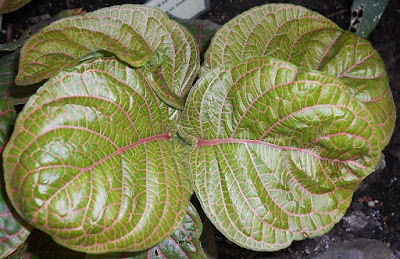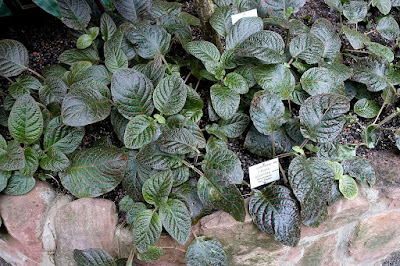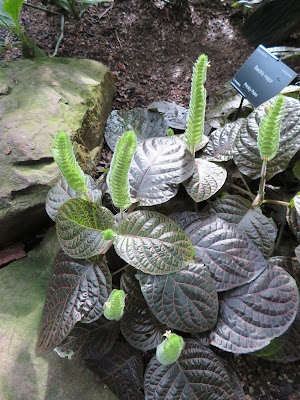Fittonia gigantea is native to tropical rainforest in South America, mainly Peru. It it is found in tropical rainforest habitats.
Fittonia gigantea, also called as Giant Leaved Nerve Plant, is a species of the genus Fittonia. This species was described by Jean Jules Linden in 1869.
IDENTIFY FITTONIA GIGANTEA - GIANT LEAVED NERVE PLANT
Fittonia gigantea is native to tropical rainforest in South America, mainly Peru. It is found in tropical rainforest habitats.
It is an evergreen perennial mat-forming, creeping plant which reaching the heights of 60 to 80 cm. ;It has purple stems that carry oval, pointed, dark-green, 16 cm long, about 8-10 cm wide leaves that have dark red veins.
Giant Leaved Nerve Plant blooms in July - August on slender spikes with 2-lipped flowers. The flowers are white and non-showy.
FITTONIA GIGANTEA - GIANT LEAVED NERVE PLANT CARE AND CULTURE
Cultural information should only be used as a guide, and should be to be adapted to suit you. Your physical location; where you grow your plants, how much time you have to devote to their care, and many other factors, will need to be taken into account. Only then can you decide on the cultural methods that best suit you and your plants.
Light:
Fittonia gigantea need low to medium light (15000-25000 lux). When growing ndoors, the plants should be kept in light above 1000 lux or they will decline rapidly. In the wild, they grow on the ground in rainforests, where sunlight is minimal. So, the best places for growing these plants are on north-facing windowsills, behind sheer curtains, or in corners away from direct sunlight.
If these plants receive too much sunlight their leaves will become burned and begin to wither. So, if you notice that your plant's leaves have brown patches and are crispy, move it to a location away from sunlight. In the winter you may have to move the plant to give it more sunlight to keep the color in the foliage
Temperature:
Giant Leaved Nerve Plant grow best in the temperature of 16 - 26°C. Never allow temperatures to dip below 15℃ or permanent damage may occur in the likes of flower loss, stunted growth and yellowed leaves. Avoid cold drafts and direct airflow from heaters in the winter months.
Humidity:
This species need a humid environment to thrive. A bathroom with enough light or a kitchen windowsill would be a great place for the plant to grow. They also love a humid terrarium. If you notice crispy tips on your plant, it could be lacking water or the humidity levels might not be high enough.
You can boost the humidity with frequent misting, placing a humidifier nearby, or using a pebble tray. Another way to increase relative humidity is to group several humidity-loving plants together in a small area, creating a micro-climate.
© twacar
Substrate and growing media:
Fittonia gigantea grows well in standard potting soil with a peat-moss base. The soil should retain some moisture but should also drain well. To ensure that the soil doesn’t become soggy, be sure to include a little coarse sand in your plant potting mixture of choice.
The plant should be repotted every one or two years in the spring to refresh their soil. Since these plants have superficial roots, they can be kept in small and shallow pots. It is important to remember that it’s always recommended to choose a container that a little bigger than the current one.
Watering:
Only allow the top inch to dry out in between waters, reducing this slightly further in the autumn and winter. Although the plant will dramatically wilt if they endure short periods of droughts, it's usually harmless and should bounce back after several hours if the foliage is functioning still.
Under-watering symptoms include a bare stem with little or no remaining leaves & stunted growth. Over-watering symptoms include yellowing lower leaves and a rotten stem. Make sure your plant is situated in a brighter environment with slightly fewer irrigations if this is the case. Never tinker with the roots unless wholly necessary during a repot as it could cause transplant shock and eventual death.
Fertilizer:
Giant Leaved Nerve Plant need fertilize with a regular houseplant fertilizer that has sufficient nutrients to keep the plants growing well. Feed your plant once a month or every other month in the period of growth (spring and summer). In late fall and in winter, you can stop feeding your plant because that’s when the plant is dormant and the growth is minimal. It’s important to water between feedings to flush the soil out and prevent the accumulation of mineral salts.
Pruning:
To promote the growth of dense, lush foliage, regularly prune your plant. The most important pruning tip for the plant is to pinch off the ends of growing stems. By pruning the plant like this, you avoid legginess and you obtain an attractive specimen. Some people also advise removing flower spikes. Although the plant produce flowers, these are discreet compared to their spectacular leaves that have colorful patterns. Pinching off the flowers encourages your plant to focus on growing its sumptuous foliage. But, if you want, you can allow your plant to flower and enjoy its delicate blooming.
© Granpic
Pests and diseases:
The major arthropod pests of this plant species include aphids, moths (worms), fungus gnats, mealybugs, mites, snails, slugs and thrips. Mealybug, and mite infestations are typically the result of bringing infested plant material near these plants. Aphids, moths, fungus gnats and thrips have the ability to fly and thus invade the greenhouse from weeds and other infested plants outside.
Propagation:
Fittonia propagation is best done by taking stem cuttings and propagating them in water or soil. They can also be propagated from seed, but this is slower and more difficult.
- Division: Split the root ball into several sections during the start of spring. Dividing too-small segments of the root-ball could lead to transplant shock or unsuccessful propagation. Sections that are at least 5cm (2 inches) in diameter serve the best chance of propagation due to the stored energy in the roots and stems. Place the sections into 'Houseplant' compost and water regularly, avoiding prolonged sunlight or persistent droughts.
- Stem Cuttings: This propagation method can be taken from spring to late summer, using between three to five leaves, with a stem length of 5cm (2 inches). Cut directly below a node using a clean knife to reduce bacteria count and remove the older 50% of the leaves. Dip the wound in some rooting hormone before setting it into a well-draining potting mix, for example a 'Houseplant' labelled compost. Blackleg can occur when the bottom wound becomes infected, typically caused by water-logging or a too-damaged wound. Maintain bright light and evenly moist soil with the avoidance of direct sunlight or cold draughts. Wrap the pot (& foliage) in a transparent bag or within a miniature greenhouse, and provide bottom hear of temperatures above 18°C (54°F). Remove the bag after a month and maintain the same cultivation. This method will take up to three months, so patience and the correct environment are paramount for success!

















COMMENTS